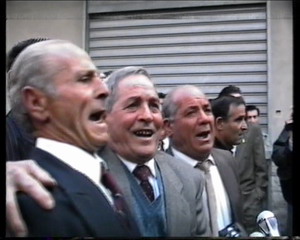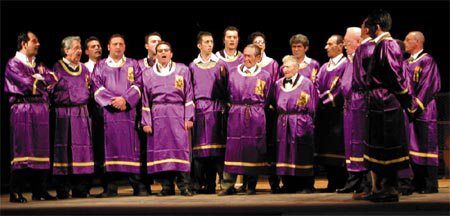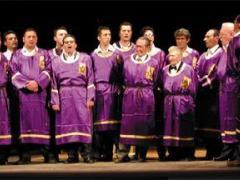Religious singing: the Santa Cruci
Street View (if present)
Description
Religious singing: the Santa Cruci

The religious song La Santa Cruci, a multi-vocal song of Holy Week, is one of the most important sound components of the Riesino repertoire, and together with other lamintances it constitutes a comment on the mythical tale represented by the rite.
The Santa Cruci is made up of eleven Parti in dialect that describe the passion and death of Jesus Christ, this Gospel story is also enriched with episodes of great symbolic effectiveness such as the pain of the Madonna in the harrowing search for the Son (the so-called cerca), the most important theme for the country during the representation of the sacred rite.
In fact, the song opens with the Mother's dialogue with the craftsmen engaged in preparing the tools for the crucifixion, the cross, the nails, the crown of thorns. In one of the parts the gjoint, the meeting between the Mother and the Risen Son. Other parts they come from evangelical texts such as the Annunciation of the Archangel Gabriel, the betrayal of Judas, the cut of the soldier's ear by Peter, the falls of Christ under the weight of the cross during the journey to Calvary, the crucifixion and in particular is the description of the centurion who pierces Christ's side with a spear. The intonation of the songs or laments reaches its most dramatic and solemn moment during the Good Friday procession, in the sad memory of the death of the Redeemer.
The performance of the songs, entrusted exclusively to male elements, alternates solo and choral voices, assuming the typical responsorial form, both monodic and polyvocal. This form is otherwise called "accord" in which one or more solo voices perform the melodic line, while the choir intervenes with intermediate or final cadences. The solo voices are generally entrusted with the enunciation of the text, performed by three said persons before purchasing,, secunna e third, while the choir is called bassu. La before purchasing, , secunna they are the only ones to carry out the verbal text, instead the third performs a long vocalization on the last three syllables of the verbal text, more or less articulated and long according to the skill of the performer.
The tonal structures and melodic lines of the polyvocal chants of Holy Week refer to forms of liturgical chant, according to the technique of the Risorgimento false border and Gregorian chant.
There are traditionally three different ways of playing La Santa Cruci: a la parrinisca, that is, in the manner of priests (parrini), therefore of liturgical and clerical origin; in la surfarara, in the manner of the miners who have borrowed and internalized the version a la parrinisca giving it a particular guttural inflection which makes it a plaintive melody, e to lu latinu, particularly popular among peasants, to be intoned with a strained voice. The denomination to lu Latin arises from the fact that the language and its meaning were not understood by the singers, who however were aware that they had stolen the language from the Church and were proud to have the privilege of a special language with which they could communicate directly with God, as did the priest himself, during the celebration of the Holy Mass in Latin. (Text source: REI data sheet - Sicily region)
----------------
Technical sheet prepared by: Region of Sicily - Department of cultural heritage and Sicilian identity - CRicd: Regional center for inventory, cataloging and documentation and Sicilian regional film library
Intangible Heritage Register
N. Prog. 69
Well: Religious Chant: the Santa Cruci
Book: REI - Book of expressions
Approval date: 26-01-2007
Category: Religious singing
Province: Caltanissetta
Municipality: Riesi
Local denomination: In Santa Cruci
Chronological News
Notary documents of the Municipality of Riesi attest to the presence of lay brotherhoods engaged in spreading complaints since the beginning of the eighteenth century.
The squads of lamenters were strongly linked to the brotherhoods until, in the second half of the nineteenth century, with the disappearance of the latter, they began to be made up of people from all walks of life, including peasants and above all sulfarai, who, starting from 1850 and for almost a century and a half, were the organizers of the festive event.
Some historical and bibliographical references indicate how important this festival was for the sulfarai, who self-taxed on their March wages to celebrate the feast of Good Friday at their expense with music, firecrackers, illuminations and long processions. In fact, a connection can be identified between the manifestation of the sacred rite of search, the relentless search for his son on the streets of the town by the Addolorata, and the dangerous activity of the sulfarai, which forced women to experience moments of despair after the disasters that occurred in the mines, in search of information about their children and husbands. Good Friday was also the only weekday of the year in which i sulfarai they did not go down to the mines.
Recurrence: Annual
Date: Good Friday
Occasion: Death of Christ the Savior
Function: Devotional
Actors: Teams of Complainers (or laudatory) review
Participants: The whole community of devotees, tourists
Description
The religious song La Santa Cruci, a multi-vocal song of Holy Week, is one of the most important sound components of the Riesino repertoire, and together with other lamintances it constitutes a comment on the mythical tale represented by the rite.
The Santa Cruci is made up of eleven Parti in dialect that describe the passion and death of Jesus Christ, this Gospel story is also enriched with episodes of great symbolic effectiveness such as the pain of the Madonna in the harrowing search for the Son (the so-called cerca), the most important theme for the country during the representation of the sacred rite.
In fact, the song opens with the Mother's dialogue with the craftsmen engaged in preparing the tools for the crucifixion, the cross, the nails, the crown of thorns. In one of the parts the gjoint, the meeting between the Mother and the Risen Son. Other parts they come from evangelical texts such as the Annunciation of the Archangel Gabriel, the betrayal of Judas, the cut of the soldier's ear by Peter, the falls of Christ under the weight of the cross during the journey to Calvary, the crucifixion and in particular is the description of the centurion who pierces Christ's side with a spear. The intonation of the songs or laments reaches its most dramatic and solemn moment during the Good Friday procession, in the sad memory of the death of the Redeemer.
The performance of the songs, entrusted exclusively to male elements, alternates solo and choral voices, assuming the typical responsorial form, both monodic and polyvocal. This form is otherwise called "accord" in which one or more solo voices perform the melodic line, while the choir intervenes with intermediate or final cadences. The solo voices are generally entrusted with the enunciation of the text, performed by three said persons before purchasing,, secunna e third, while the choir is called bassu. La before purchasing, , secunna they are the only ones to carry out the verbal text, instead the third performs a long vocalization on the last three syllables of the verbal text, more or less articulated and long according to the skill of the performer.
The tonal structures and melodic lines of the polyvocal chants of Holy Week refer to forms of liturgical chant, according to the technique of the Risorgimento false border and Gregorian chant.
There are traditionally three different ways of playing La Santa Cruci: a la parrinisca, that is, in the manner of priests (parrini), therefore of liturgical and clerical origin; in la surfarara, in the manner of the miners who have borrowed and internalized the version a la parrinisca giving it a particular guttural inflection which makes it a plaintive melody, e to lu latinu, particularly popular among peasants, to be intoned with a strained voice. The denomination to lu Latin arises from the fact that the language and its meaning were not understood by the singers, who however were aware that they had stolen the language from the Church and were proud to have the privilege of a special language with which they could communicate directly with God, as did the priest himself, during the celebration of the Holy Mass in Latin.
Catalog Sheet
REFERENCES
Baglio, Cajetan. 1905. The solfaraio. Naples: Luigi Pierro Editore.
Bonanzinga, Sergio. Sound forms and symbolic space. Archive of Sicilian folk traditions, 31-32.Palermo: New graphicadue, 1992.
Buttitta, Antonino and Melo Minnella. 1978. Easter in Sicily. Palermo: Grafindustria publisher.
Buttitta, Ignazio Emanuele and Rosario Perricone. 1996. Sounds and cultures, Sound documents from the Sicilian Ethnomusical Archive. Palermo: CIMS.
Buttitta, Ignazio Emanuele. 2002. The long memory. Symbols and rites of traditional religiosity. Rome:Melt me.
Favara, Albert. 1957. Corpus of Sicilian folk music. Palermo: Academy of Sciences, Letters and Arts.
Iron, Salvatore. 1934. The history of Riesi, from its origins to the present day. Caltanissetta: Tip. Marco's.
Grenade, Salvatore. 2009. The singing of the Santa Cruci in Riesi, in Bulletin of the Nastroteca 2008. Activities, researches, acquisitions. Arise, Orietta, edited by. Palermo: CRICD.
Macchiarella, Ignatius. Songs of Holy Week in Sicily. Archive of Sicilian Popular Traditions, 33-34. Palermo: Sicilian Graphic Arts, 1995.
Macchiarella, Ignatius. 1995. The false border between oral tradition and written tradition. Lucca: Italian Music Library.
Head, Giuseppe. 1981. I succeeded in the story. Palermo: Archives of Sicily Editorial Center.
Sitography
Filmography
Discography
Arise, Orietta, edited by. The songs of the Passion. Bulletin of the Nastroteca 2008. Activities, researches, acquisitions, 2. Palermo: CRICD, 2009. CD-ROM.
Footnotes
To prevent them from being forgotten, the parts of the religious song of La Santa Cruci were collected by the voice of some elderly and transcribed on a flyer at the behest of the then parish priest of Riesi, Don Scuderi, at the end of the 70s.
In the mid-70s, when Don Scuderi was still parish priest, a group of singers went to Caltanissetta to participate in a singing event of Holy Week, on the occasion of which, in addition to being a great success, he was awarded the first prize.
Some teams of Rieti singers, on the occasion of the celebrations of Holy Week, it seems they also went previously to Caltanissetta to exhibit their repertoire, news confirmed by Ignazio Macchiarella who writes: "on Holy Thursday, as in ancient times, today too many groups of laudatants flock from neighboring countries, often sent and paid for by the classes, and sometimes even spontaneously, with the hope of earning two pairs of tarì".
Salvatore Carrubba represents the most important living historical source, he is in fact the last of the laudatantsremained alive, the only one who knows how to interpret the two ways of popular song can, at the surfarara andparrinisca.
The lack of interest on the part of young people who did not allow the generational change causing the temporary disappearance of the squads of lamenters. After 1991, one has to wait until Easter 2006 to have a new performance by the group led by Carrubba during the procession with the urn that goes to Calvary to welcome the remains of the dead Christ: a moment of maximum expressive intensity. On that occasion the people present, emotionally involved, showed great amazement and the young people, but also the not so young, approached, showing interest and giving their willingness to learn the parts of La Santa Cruci. From this moment on, the singers organized themselves better and exhibited the repertoire during the various processions, giving vitality to a tradition that now seemed forgotten.
The Riesini Emigranti Association (ARE), whose culture manager is Salvatore Granata, promotes initiatives aimed at recomposing the complainers and the foundation of a school for aspiring singers with the aim of keeping the historical memory of the town alive.
Author Profile: Maria Rosaria Paterno '
Some passages of the religious song The Santa Cruci, taken from The songs of the Passion. Bulletin of the Nastroteca 2008. Activities, researches, acquisitions, CD2. Palermo: CRICD, 2009.
Go to Google Maps
Send a notice to the publisher
[contact-form-7 id="18385"]





